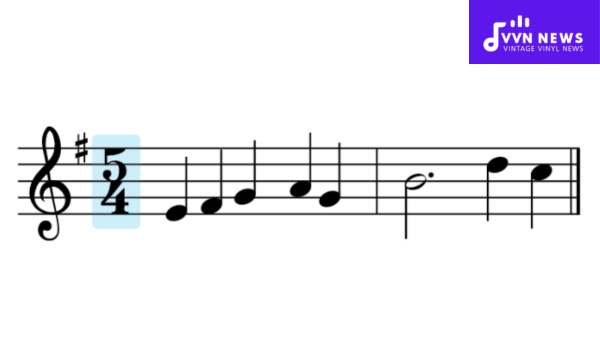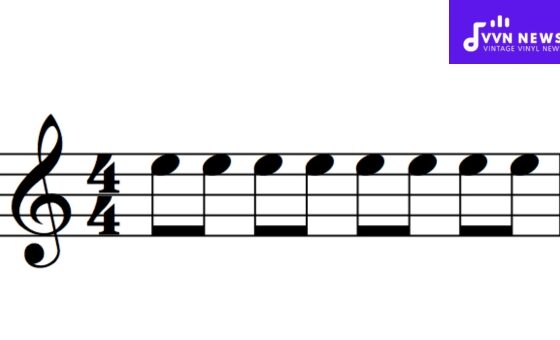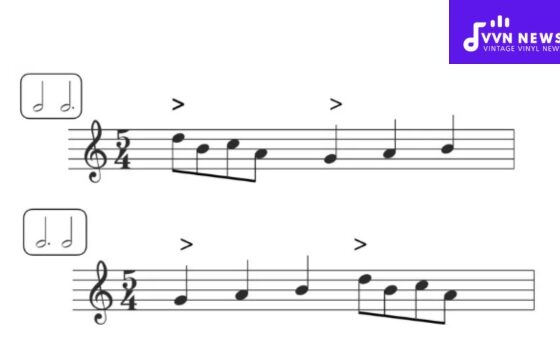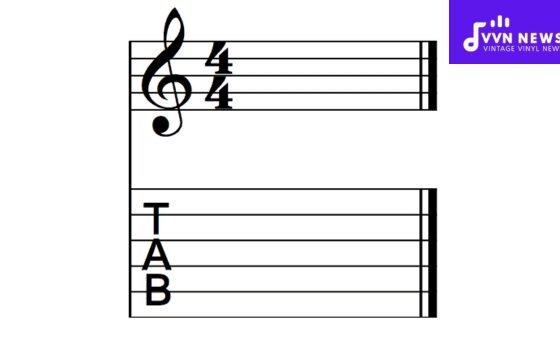Discover the unique rhythm and compelling freedom of playing in time signature 5/4. Unlike most common time signatures that you may be used to, such as 4/4 or 3/4, a piece of music within a 5/4 time signature always adds a distinctive flavor to any melody.
Even if you are not a musician, this slightly complex but captivating time signature can enhance your music appreciation. If you have ever tapped your foot along to the beat of a song, then you have instinctively identified the underlying time signature.
Introducing yourself to the universe of 5/4 will open up an array of possibilities and transform your perspective on how we interact with rhythm in music.
What is Time Signature 5/4?
Time signature 5/4, often written as 5/4, dictates that a musical piece has five quarter note beats per measure.
Each number in the fraction holds a specific role: the top ‘5’ indicates how many beats are contained within a single measure, while the bottom ‘4’ reveals that a quarter note represents one beat.
This time signature is irregular compared to the common 4/4 meter, bringing forth an intriguing and unexpected rhythmic pattern that can provide both challenges and creative opportunities for composers and musicians alike.
The asymmetrical nature of 5/4 gives the music a unique pulse, separating it from more conventional grooves.
Also Read: F Sharp Minor Pentatonic Scale [How To Use In Your Compositions]
Why is 5/4 Considered a Complex Time Signature?
The 5/4 time signature is often viewed as intricate primarily due to its uneven grouping of beats.
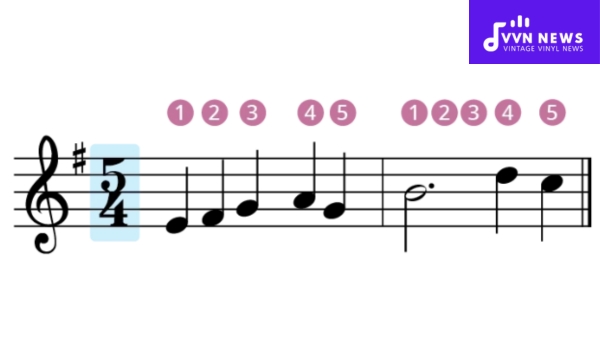
This stands in contrast to the symmetry found in common signatures like 4/4 or 3/4, where beats naturally divide into equal halves or thirds.
With five beats per measure, musicians and listeners alike must navigate a rhythmic landscape that doesn’t lend itself to straightforward divisions.
The first beat of each measure is usually emphasized (accented), providing a reference point, but the remaining four beats can be split in various ways, such as a 3+2 or 2+3 pattern.
This flexibility leads to rich and unpredictable rhythms that can be both thrilling and challenging to master.
The quintessential oddity of dividing measures into five beats gives rise not just to complex rhythms but also compels one to delve deeper into their musical sensibilities.
Discovering and adapting to this atypical pulse requires patience and a keen rhythmical sense, making 5/4 an exciting endeavor for those eager to explore beyond conventional musical boundaries.
How Do You Count in 5/4 Time?
Counting in 5/4 time may initially feel foreign, but with a bit of practice, you’ll find it’s quite straightforward.
Picture the time signature split into five beats per measure, and each beat as a quarter note.
- Break It Down: Consider conceptualizing the beats in groups — often in a pattern of 3+2 or 2+3. This helps create a mental map for where to place the emphasis when counting.
- The Counting Rhythm: When employing the 3+2 structure, count as follows: “1-2-3 4-5,” with bold numbers indicating strong beats. Alternatively, if you are using a 2+3 pattern, count: “1-2 3-4-5.”
To stay in rhythm, try using a metronome set to the 5/4 time signature or tap along to songs that utilize this meter.
Consistency is key — keep your counting steady and unvarying throughout.
Also Read: E Minor Pentatonic Scale [How To Use In Your Music Composition]
Which Songs Utilize the 5/4 Time Signature?
The 5/4 time signature is a unique rhythmic pattern that offers a distinct, unconventional feel to music.
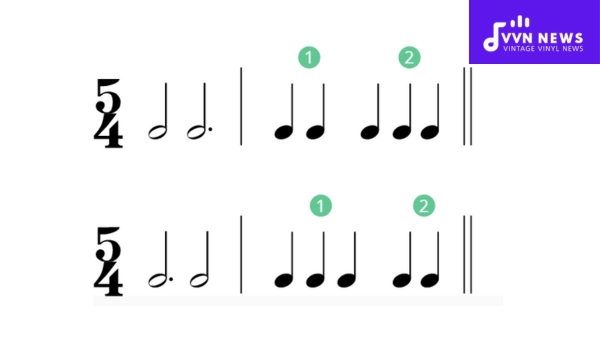
Despite its rarity compared to more standard time signatures, several popular songs have embraced the complexities of 5/4 to great effect.
“Take Five” by The Dave Brubeck Quartet
This jazz classic is arguably the most famous piece written in 5/4.
Composed by Paul Desmond and performed by The Dave Brubeck Quartet, “Take Five” stands as a hallmark of experimental jazz from their seminal 1959 album Time Out.
Its mesmerizing saxophone melodies weave through each bar’s five beats, consolidating its place in music history.
“Living in the Past” by Jethro Tull
British rock group Jethro Tull’s “Living in the Past” showcases how rock can incorporate unconventional rhythms effectively.
With a catchy melodic hook accentuating the quintuple meter’s first and third beats, this song blurs lines between progressive rock and jazz influences.
“Seven Days” by Sting
Sting ventures into complex rhythms with his song “Seven Days,” from his 1993 album Ten Summoner’s Tales.
Notably crafted within a framework showcasing his musically explorative nature, this song demonstrates how pop-rock can combine cerebral artistry with accessibility.
“Everything’s Alright” from Jesus Christ Superstar
A gem from Andrew Lloyd Webber’s iconic rock opera Jesus Christ Superstar, “Everything’s Alright” displays how theatre often incorporates various time signatures for dramatic effect.
Yvonne Elliman initially voiced this remarkable tune that rhythmically rotates through its verses with grace.
“River Man” by Nick Drake
Nick Drake’s folk melancholy finds a perfect match with the 5/4 time signature in his song “River Man.”
This track from his album Five Leaves Left combines hushed vocals with intricate string arrangements, offering an exquisite auditory tapestry befitting its unusual rhythm.
These tracks each uniquely employ the distinctive characteristics of the 5/4 beat, transforming ordinary musical expectations into extraordinary auditory experiences—showcasing creativity that transcends typical rhythmic boundaries.
Also Read: Phrygian Mode [Adding Exotic Flair To Your Musical Compositions]
How Can Ear Training Help With Meters?
Ear training is a critical tool in mastering the nuances of different time signatures, especially when delving into meters like 5/4.
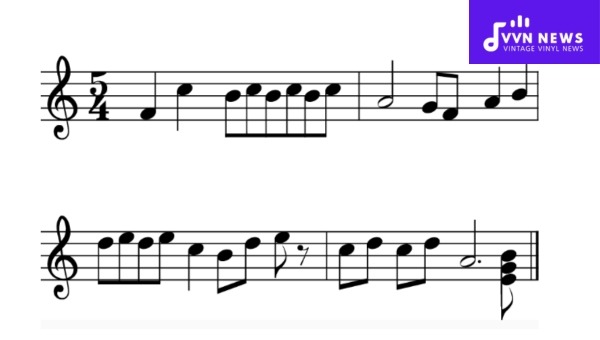
By honing your listening skills, you can better grasp the underlying patterns that define a piece’s rhythm and enhance your overall musicality.
Recognize Patterns
Firstly, ear training enables you to identify rhythmic patterns. In music, patterns are like the building blocks of a meter.
For someone exploring 5/4 time, recognizing the quintuple meter’s distinctive one-two-three-one-two pulse—or any variation thereof—becomes more intuitive with trained ears.
Improve Timing
Focused listening practices can sharpen your sense of timing. You begin to anticipate where beats fall within a bar.
As you internalize this pulse in different time signatures through ear training exercises, maintaining the natural flow of more complex rhythms like 5/4 comes with greater ease.
Develop Internal Metronome
An essential aspect of ear training is developing an internal metronome—an invaluable skill for any musician or music enthusiast.
This allows you to keep track of beats and measures without relying on visual cues or an actual metronome while interpreting meters outside the standard ones.
Enhance Musical Interpretation
By distinguishing various rhythmic nuances through ear training, you’ll gain insights into how different meters influence musical expression.
The odd symmetry of 5/4 can project tension or propulsion, often lost without a finely tuned ear.
Adaptability in Performance and Listening
Lastly, effective ear training cultivates adaptability in both performance and active listening contexts.
It prepares you to engage with unfamiliar compositions that employ unconventional meters—responding not only intellectually but also emotionally to their distinct rhythmic landscapes.
To excel in perceiving complex rhythms like those characterized by 5/4, investing time in targeted ear training exercises will undeniably pay off.
Also Read: A Sharp Minor Pentatonic Scale [Unique Harmonic Possibilities]
FAQs
What exactly do the “5” and the “4” represent in a 5/4 time signature?
The “5” indicates that there are five beats in a measure, while the “4” denotes that a quarter note receives one beat.
Is a 5/4 time signature commonly used in popular music?
Although it’s less common than 4/4, some popular songs, like Take Five by Dave Brubeck, feature the 5/4 time signature.
Can you clap out a basic rhythm in 5/4 to better understand it?
Absolutely! Try clapping a steady rhythm counting 1-2-3-1-2, where each number represents a beat to feel the flow of 5/4.
Does learning to play in 5/4 offer benefits for musicians?
Mastering 5/4 time can enhance a musician’s rhythmic proficiency and versatility across different musical genres.
Where can I find examples of classical music written in 5/4 time?
Gustav Holst’s The Planets features movements that exemplify the use of 5/4, such as “Mars, the Bringer of War.”
Conclusion
In the grand tapestry of musical composition, a 5/4 time signature stands out as a mesmerizing weave. It’s the unexpected pulse, that creates intricate patterns that capture our imagination.
Experiencing 5/4 can be a transformative journey. As you delve into the richness of this time signature, count with a combination of patience and intuition, and listen to its presence in popular tracks, you will unlock a new layer of rhythmic sophistication.
It’s an exciting venture that echoes the timeless beauty of music’s diverse landscape. Explore it actively and let it inspire your auditory adventures.
